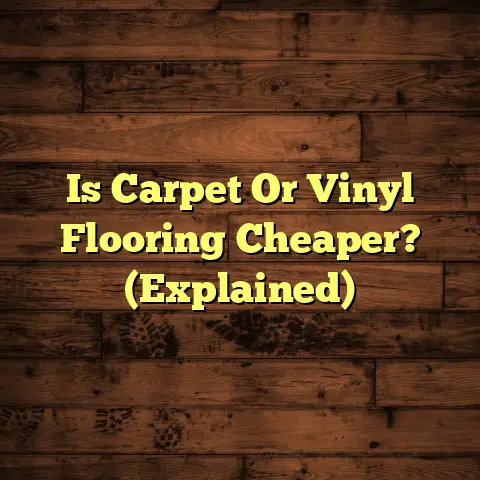Home Gym Floor Protection (Pro’s Secret Tip!)
A Pro’s Secret Tip to Keep Your Space Safe and Stylish
Let’s talk about something close to my heart – your home gym.
I know the feeling. The sheer excitement of carving out that dedicated space, the pride in assembling your equipment.
It’s more than just a room; it’s your personal sanctuary.
I remember setting up my first home gym. Early mornings filled with energy, the satisfying clank of weights, pushing my limits.
But there was always a nagging worry: was I slowly destroying the floor beneath me?
The thought of costly repairs or unsightly damage always lingered in the back of my mind.
The truth is, investing in your health is amazing, but protecting that investment is just as crucial.
Trust me, I’ve seen it all.
I’ve witnessed beautiful hardwood floors scarred by dropped dumbbells, carpets stained with sweat and torn by equipment, and tiles cracked under the pressure of heavy weights.
It’s heartbreaking, and frankly, completely avoidable.
That’s why I’m here to share a pro’s secret tip to keep your home gym floor safe, stylish, and ready for anything you throw at it.
Ready to dive in? Let’s get started!
Section 1: The Importance of Floor
Protection in Home Gyms
Okay, let’s get real.
Why is floor protection so important?
Think about it: your home gym is a high-impact zone.
We’re talking dropped weights, jumping exercises, and constant movement that puts a serious strain on your flooring.
But what kind of flooring do you currently have in your gym?
Let’s break down the common culprits:
-
Hardwood: Beautiful, but oh-so-delicate. Scratches, dents, and water damage are its worst enemies.
-
Carpet: Absorbs sweat like a sponge and can be easily torn by equipment. Plus, good luck trying to clean it after a particularly grueling workout.
-
Concrete: Durable, yes, but also unforgiving. Dropped weights can cause cracks, and it’s not exactly comfortable to exercise on.
-
Tile: Prone to cracking under heavy impact, and replacing tiles can be a pain.
I’ve seen firsthand the damage that can occur.
I once had a client who dropped a dumbbell on their hardwood floor, leaving a deep gouge that cost hundreds to repair.
Another client had to replace their entire carpet after it became infested with mold from trapped sweat.
No fun, right?
According to a study by the National Association of Home Builders, the average cost to repair hardwood floors is between \$300 and \$800, while replacing carpet can range from \$500 to \$2,000. (Source: https://www.nahb.org/)
These numbers don’t even factor in the emotional toll of dealing with damage to your home.
Imagine the frustration of seeing your beautiful floors ruined, or the disappointment of having to cut your workout short to clean up a mess.
I’ve heard countless stories from gym owners who neglected floor protection and regretted it.
One client, Sarah, told me she was so focused on getting in shape that she didn’t think about protecting her floors.
“I thought, ‘It’s just a few weights, what could happen?'” she said.
“But after a few months, my hardwood floors were covered in scratches and dents. It looked terrible!”
Sarah ended up spending a fortune to refinish her floors, and she learned a valuable lesson: floor protection is an investment, not an expense.
Don’t let Sarah’s story be yours.
Protect your investment, protect your floors, and protect your peace of mind.
Section 2: Materials Matter: Choosing the Right Flooring for Your Home Gym
Alright, so we know floor protection is essential.
But what are your options?
Luckily, there’s a wide range of flooring materials designed specifically for home gyms.
Let’s break down the most popular choices:
-
Rubber Flooring: The gold standard for home gyms. Durable, shock-absorbent, and water-resistant. Available in rolls, tiles, and mats.
- Pros: Excellent protection, easy to clean, long-lasting, and available in various thicknesses and colors.
- Cons: Can be expensive, may have a slight rubber smell initially, and some types can be heavy to install.
-
Foam Mats: A budget-friendly option that provides decent cushioning. Great for bodyweight exercises and light weightlifting.
- Pros: Affordable, lightweight, easy to install and move around, and provides good cushioning for joints.
- Cons: Not as durable as rubber, can be easily punctured or torn, and may not be suitable for heavy weightlifting.
-
Vinyl Flooring: A versatile option that offers a good balance of durability and affordability. Available in sheets, tiles, and planks.
- Pros: Water-resistant, easy to clean, available in various styles and colors, and more durable than carpet.
- Cons: Not as shock-absorbent as rubber or foam, can be slippery when wet, and may not be suitable for heavy weightlifting.
I always recommend rubber flooring for serious home gym enthusiasts.
It’s simply the best option for protecting your floors from heavy impact and providing a safe and comfortable workout surface.
However, foam mats can be a great choice if you’re on a budget or primarily do bodyweight exercises.
Vinyl flooring is a good middle ground, offering decent protection and durability at a reasonable price.
I remember helping a client, Mark, transform his garage into a home gym.
He initially had concrete floors, which were cold, hard, and unforgiving.
After discussing his options, we decided to install rubber flooring.
The difference was night and day.
“It’s like working out on a cloud,” Mark told me.
“The rubber flooring absorbs the impact of the weights, and it’s so much more comfortable on my joints.”
Mark also noticed a significant reduction in noise, which was a big plus for his family.
Another client, Lisa, switched from carpet to foam mats in her home gym.
She was tired of the constant cleaning and the lingering smell of sweat.
“The foam mats are so easy to clean,” Lisa said.
“I just wipe them down after each workout, and they’re good to go. Plus, they’re much more comfortable than the carpet was.”
The key is to choose the flooring material that best suits your needs, budget, and workout style.
Don’t be afraid to do your research, read reviews, and ask for samples before making a decision.
And remember, investing in quality flooring is an investment in your health and your home.
Section 3: The Pro’s Secret Tip: Optimal Floor Protection Techniques
Okay, time for the good stuff.
I’m about to reveal the pro’s secret tip for optimal floor protection.
Are you ready?
Here it is: Layering is key!
That’s right, don’t rely on just one layer of protection.
Combine different materials and techniques to create a comprehensive defense against damage.
Here’s a step-by-step guide on how to implement this tip effectively:
-
Start with a Base Layer: This is your primary flooring material, such as rubber flooring, foam mats, or vinyl flooring. Make sure it’s properly installed and covers the entire gym area.
-
Add Targeted Protection: Identify the areas that are most vulnerable to damage, such as under weight benches, squat racks, and deadlift platforms. Place additional protective mats or pads in these areas.
-
Use Equipment Mats: Place mats underneath all of your equipment, such as treadmills, ellipticals, and stationary bikes. This will help absorb vibrations and prevent scratches.
-
Invest in Weightlifting Pads: If you lift heavy weights, invest in weightlifting pads or crash pads. These pads are designed to absorb the impact of dropped weights and protect your floors from damage.
-
Practice Proper Lifting Technique: This may seem obvious, but it’s worth mentioning. Proper lifting technique can significantly reduce the risk of dropping weights and damaging your floors.
I spoke with several fitness trainers and gym owners to get their thoughts on floor protection.
Here’s what they had to say:
“Floor protection is not just about preventing damage, it’s about creating a safe and comfortable workout environment,” said certified personal trainer, David Miller.
“When your floors are protected, you can focus on your workout without worrying about damaging your home.”
“I always tell my clients to invest in quality floor protection,” said gym owner, Maria Rodriguez.
“It’s a small price to pay for the peace of mind it provides. Plus, it makes the gym look more professional and inviting.”
I remember working with a client, Tom, who was hesitant to invest in additional floor protection.
He already had rubber flooring, and he thought that was enough.
But after I explained the benefits of layering, he decided to give it a try.
We added weightlifting pads under his squat rack and deadlift platform, and he immediately noticed a difference.
“I feel so much more confident lifting heavy weights now,” Tom said.
“I know that if I accidentally drop the weight, my floors are protected.”
Tom also appreciated the added cushioning that the weightlifting pads provided.
“My knees feel so much better after squatting,” he said.
“I wish I had done this sooner!”
Don’t make the same mistake as Tom.
Take the time to implement these floor protection techniques, and you’ll be rewarded with a safe, stylish, and long-lasting home gym.
Section 4: Cost vs. Value: The Long-Term Benefits of Investing in Floor Protection
Let’s talk about money.
I know, it’s not the most exciting topic, but it’s important to consider the cost versus the value of investing in floor protection.
On the surface, it may seem like an unnecessary expense.
But when you compare the cost of protective flooring to the potential cost of repairing or replacing damaged floors, the value becomes clear.
Let’s break down the costs:
- Rubber Flooring: \$3 to \$8 per square foot
- Foam Mats: \$1 to \$3 per square foot
- Vinyl Flooring: \$2 to \$5 per square foot
- Weightlifting Pads: \$50 to \$200 per pair
- Equipment Mats: \$20 to \$50 per mat
Now, let’s compare those costs to the potential cost of repairs:
- Hardwood Floor Repair: \$300 to \$800
- Carpet Replacement: \$500 to \$2,000
- Tile Repair: \$200 to \$500
As you can see, the cost of floor protection is significantly less than the cost of repairs.
But the value of investing in quality flooring goes beyond just preventing damage.
A well-maintained home gym can actually increase your property value.
According to a study by Zillow, homes with dedicated workout spaces sell for 2% to 3% more than comparable homes. (Source: https://www.zillow.com/)
That’s because a home gym is seen as a desirable amenity that adds value to the home.
But the most important benefit of investing in floor protection is the emotional one.
A well-maintained home gym can motivate you to commit to your fitness journey.
When you have a dedicated space that is clean, safe, and inviting, you’re more likely to use it regularly.
I’ve seen it happen time and time again.
Clients who invest in their home gym are more likely to stick with their workout routines and achieve their fitness goals.
I remember working with a client, Susan, who was struggling to stay motivated to work out.
She had a small home gym in her basement, but it was cluttered, dirty, and uninviting.
After we cleaned up the space, installed new rubber flooring, and added some motivational artwork, Susan’s attitude completely changed.
“I actually look forward to working out now,” she said.
“My home gym is no longer a place I dread going to. It’s a place where I feel energized and inspired.”
Susan went on to lose weight, gain strength, and improve her overall health.
And it all started with investing in her home gym.
Don’t underestimate the power of a well-maintained workout space.
It can transform your fitness journey and help you achieve your goals.
So, ask yourself: are you willing to invest in your health and your home?
The answer should be a resounding yes!
Section 5: Maintenance and Care: Extending the Life of Your Home Gym Floor
You’ve invested in quality flooring and implemented the pro’s secret tip for optimal floor protection.
Now what?
It’s time to talk about maintenance and care.
Proper maintenance is essential for extending the life of your home gym floor and keeping it looking its best.
Here are some practical tips:
-
Regular Cleaning: Sweep or vacuum your floors regularly to remove dirt, dust, and debris. For rubber and vinyl flooring, you can also mop with a mild detergent and water.
-
Spot Cleaning: Clean up spills and stains immediately to prevent them from setting in. Use a clean cloth and a mild cleaning solution.
-
Protective Accessories: Use mats and pads under your equipment to prevent scratches and dents. Consider using shoe covers to protect your floors from dirt and debris.
-
Proper Ventilation: Ensure that your home gym is well-ventilated to prevent the buildup of moisture and mold.
-
Regular Inspections: Inspect your floors regularly for signs of damage, such as cracks, tears, or discoloration. Address any issues promptly to prevent them from worsening.
I remember working with a client, John, who was meticulous about maintaining his home gym.
He cleaned his floors every day, used protective mats under his equipment, and regularly inspected for any signs of damage.
As a result, his floors looked brand new, even after years of use.
“I treat my home gym like I treat my car,” John said.
“I take care of it, and it takes care of me.”
John’s dedication to maintenance paid off in the long run.
He never had to deal with costly repairs or replacements, and his home gym remained a source of pride and motivation.
Another client, Emily, learned the importance of maintenance the hard way.
She neglected her home gym floors, and they quickly became dirty, stained, and damaged.
“I was so focused on working out that I didn’t pay attention to the condition of my floors,” Emily said.
“By the time I realized how bad they were, it was too late. I had to replace the entire flooring.”
Emily’s experience is a reminder that maintenance is not optional.
It’s an essential part of owning a home gym.
By following these simple tips, you can extend the life of your floors and keep your workout space looking its best.
And remember, a well-maintained home gym is a reflection of your commitment to your health and well-being.
Conclusion: Empowering Your Fitness Journey with the Right Floor Protection
We’ve covered a lot of ground.
We’ve talked about the importance of floor protection, the different types of flooring materials, the pro’s secret tip for optimal protection, the cost versus the value of investing in quality flooring, and the importance of maintenance and care.
Now it’s time to put everything into action.
Remember, your home gym is more than just a room.
It’s a sanctuary, a place where you can escape the stresses of daily life and focus on your health and well-being.
By protecting your floors, you’re not just protecting your investment, you’re protecting your fitness journey.
You’re empowering yourself to pursue your goals without hindrance.
So, take the first step today.
Implement the pro’s secret tip, invest in quality flooring, and commit to regular maintenance.
You’ll be amazed at the difference it makes.
You’ll feel more confident, more motivated, and more empowered to achieve your fitness goals.
Don’t let damaged floors hold you back.
Embrace the freedom and confidence that comes with a protected workout space.
Your health is worth it, your home is worth it, and you are worth it.
Now go out there and create the home gym of your dreams!





